Related Research Articles

Kristallnacht (German pronunciation:[kʁɪsˈtalnaχt]lit. 'crystal night') or the Night of Broken Glass, also called the November pogrom(s) (German: Novemberpogrome, pronounced[noˈvɛm.bɐ.poˌɡʁoːmə] ), was a pogrom against Jews carried out by the Nazi Party's Sturmabteilung (SA) and Schutzstaffel (SS) paramilitary forces along with some participation from the Hitler Youth and German civilians throughout Nazi Germany on 9–10 November 1938. The German authorities looked on without intervening. The euphemistic name Kristallnacht comes from the shards of broken glass that littered the streets after the windows of Jewish-owned stores, buildings, and synagogues were smashed. The pretext for the attacks was the assassination of the German diplomat Ernst vom Rath by Herschel Grynszpan, a 17-year-old German-born Polish Jew living in Paris.

Der Stürmer was a weekly German tabloid-format newspaper published from 1923 to the end of World War II by Julius Streicher, the Gauleiter of Franconia, with brief suspensions in publication due to legal difficulties. It was a significant part of Nazi propaganda, and was virulently anti-Semitic. The paper was not an official publication of the Nazi Party, but was published privately by Streicher. For this reason, the paper did not display the Nazi Party swastika in its logo.
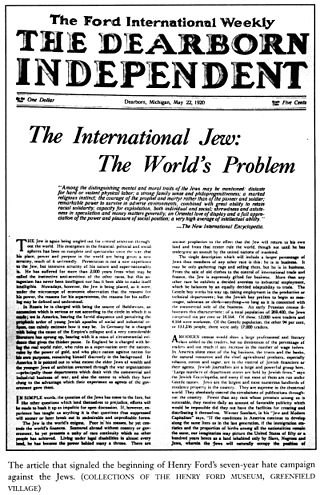
The Dearborn Independent, also known as The Ford International Weekly, was a weekly newspaper established in 1901, and published by Henry Ford from 1919 through 1927. The paper reached a circulation of 900,000 by 1925, second only to the New York Daily News, largely due to a quota system for promotion imposed on Ford dealers. Lawsuits regarding antisemitic material published in the paper caused Ford to close it, and the last issue was published in December 1927. The publication's title was derived from the Detroit suburb of Dearborn, Michigan.
Friedrich Münzer was a German classical scholar noted for the development of prosopography, particularly for his demonstrations of how family relationships in ancient Rome connected to political struggles. He died in Theresienstadt concentration camp.

Reichsgau Danzig-West Prussia was an administrative division of Nazi Germany created on 8 October 1939 from annexed territory of the Free City of Danzig, the Greater Pomeranian Voivodship, and the Regierungsbezirk West Prussia of Gau East Prussia.
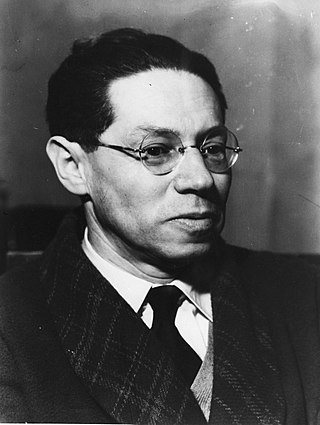
Lion Feuchtwanger was a German Jewish novelist and playwright. A prominent figure in the literary world of Weimar Germany, he influenced contemporaries including playwright Bertolt Brecht.
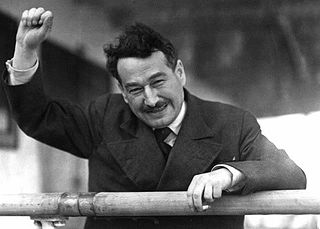
Egon Erwin Kisch was an Austrian and Czechoslovak writer and journalist, who wrote in German. He styled himself Der Rasende Reporter for his countless travels to the far corners of the globe and his equally numerous articles produced in a relatively short time, Kisch was noted for his development of literary reportage, his opposition to Adolf Hitler's Nazi regime, and his Communism.
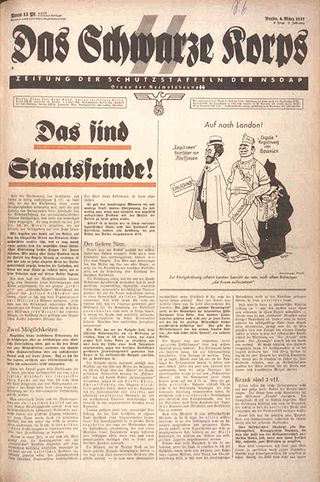
Das Schwarze Korps was the official newspaper of the Schutzstaffel (SS). This newspaper was published on Wednesdays and distributed free of charge. All SS members were encouraged to read it. The chief editor was SS leader Gunter d'Alquen; the publisher was Max Amann of the Franz-Eher-Verlag publishing company. The paper was hostile to many groups, with frequent articles condemning the Catholic Church, Jews, Communism, Freemasonry, and others.

The German National Library is the central archival library and national bibliographic centre for the Federal Republic of Germany. It is one of the largest libraries in the world. Its task is to collect, permanently archive, comprehensively document and record bibliographically all German and German-language publications since 1913, foreign publications about Germany, translations of German works, and the works of German-speaking emigrants published abroad between 1933 and 1945, and to make them available to the public. The DNB is also responsible for the Deutsche Nationalbibliografie and several special collections like the Deutsches Exilarchiv 1933–1945, Anne-Frank-Shoah-Bibliothek and the Deutsches Buch- und Schriftmuseum. The German National Library maintains co-operative external relations on a national and international level. For example, it is the leading partner in developing and maintaining bibliographic rules and standards in Germany and plays a significant role in the development of international library standards. The cooperation with publishers has been regulated by law since 1935 for the Deutsche Bücherei Leipzig and since 1969 for the Deutsche Bibliothek Frankfurt am Main.

The propaganda used by the German Nazi Party in the years leading up to and during Adolf Hitler's dictatorship of Germany from 1933 to 1945 was a crucial instrument for acquiring and maintaining power, and for the implementation of Nazi policies.

Das Reich was a weekly newspaper founded by Joseph Goebbels, the propaganda minister of Nazi Germany, in May 1940. It was published by Deutscher Verlag.

Joachim Prinz was a German-American rabbi who was an outspoken activist against Nazism in Germany in the 1930s and later became a leader in the civil rights movement in the United States in the 1960s.

Ulrich Fleischhauer was a leading publisher of antisemitic books and news articles reporting on a perceived Judeo-Masonic conspiracy theory and "nefarious plots" by clandestine Jewish interests to dominate the world.
During the nine decades since its establishment in 1919, the Communist Party USA produced or inspired a vast array of newspapers and magazines in at least 25 different languages. This list of the Non-English press of the Communist Party USA provides basic information on each title, along with links to pages dealing with specific publications in greater depth.
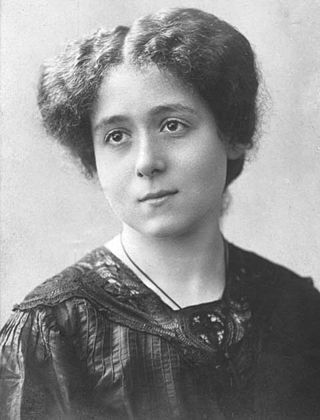
Bertha Badt-Strauss was a German writer and Zionist. She wrote for numerous Jewish publications in Berlin and the United States, and edited and translated the works of many other writers.
Friedrich Porges (1890–1978) was an Austrian-American film director of the silent era, journalist, publisher, screenwriter, author and film critic. Of Jewish background, he fled Vienna just prior to the Anschluss of 1938 and emigrated to Britain and the United States.

Otto Friedrich Wilhelm Stapel, was a German Protestant and nationalist essayist. He was the editor of the influential antisemitic monthly magazine Deutsches Volkstum from 1919 until its shutdown by the Nazis in 1938.

Die BIF – Blätter Idealer Frauenfreundschaften, subtitled Monatsschrift für weibliche Kultur, was a short-lived lesbian magazine of Weimar Germany, published from either 1925 or 1926 until 1927 in Berlin. Founded by lesbian activist Selli Engler, Die BIF was part of the first wave of lesbian publications in history and the world's first lesbian magazine to be published, edited and written solely by women.

Julie Elias was a German fashion journalist and author of cookbooks, which also dealt with Jewish cuisine. She was worldly, highly educated, and during her lifetime was known beyond the borders of Germany as a culinary salonnière and successful writer. In 1938, persecuted as a Jew, she had to flee Germany. After the destruction of European Jewry in the Holocaust, there were hardly any traces of her left in the public memory.

Die Brennessel was a weekly satirical magazine which was published in Munich, Germany, between 1931 and 1938. It was one of the publications which were established to gain popularity among Germans in favor of the Nazi Party. The magazine employed humor as a tool for Nazi propaganda.
References
- ↑ "Der Morgen". The UC San Diego Library Catalog. Retrieved 11 January 2018.
- 1 2 3 4 5 Fraiman, Sarah (2000). "The Transformation of Jewish Consciousness in Nazi Germany as Reflected in the German Jewish Journal Der Morgen, 1925–1938". Modern Judaism. 20 (1): 41–59. JSTOR 1396629.
- ↑ Kaplan, Edward K.; Dresner, Samuel H. (1998). Abraham Josua Heschel: Prophetic Witness. New Haven, CT: Yale University Press. p. 341. ISBN 0300071868.